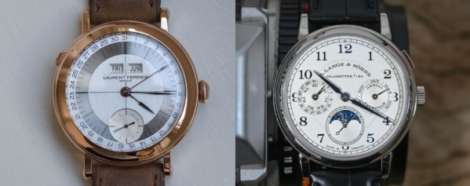Slim kings – the Piaget Altiplano 40mm Ultra-Thin Date and the Altiplano Chronograph
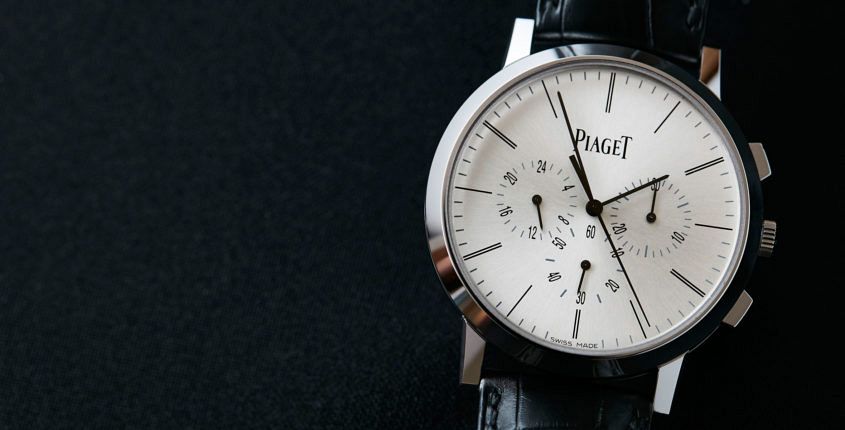 A few weeks ago we were treated to an evening with Piaget, and their thintastic Altiplano collection. And while we had a bunch of watches in our office, and our excellent photographer Jason Reekie on hand, it would have been a shame not to make the most of it. We’ve already seen what the mighty meteorite dial looks like in crisp focus under good lights, and now it’s time for two others — the 40mm Altiplano Date and the Altiplano Chronograph. Piaget Altiplano Chronograph Flyback Dual Time OK, so if you’re anything like me, a chronograph isn’t the first thing that comes to mind when you think of Piaget, or indeed of ultra-thin watches. But here we are. And here is Piaget’s take on what’s typically a très sporty watch. First seen in 2015, the Altiplano Chronograph — here in white gold — is impressive, not just for its delicate proportions (41mm wide and only 8.24mm thin for the fully cased watch; the movement is a mere 4.65mm), but also for the fact that this is a new, from-the-ground-up movement, and a manually wound column wheel flyback with a GMT at that. Technique aside, this thing is gorgeous. Clean and stylish…
A few weeks ago we were treated to an evening with Piaget, and their thintastic Altiplano collection. And while we had a bunch of watches in our office, and our excellent photographer Jason Reekie on hand, it would have been a shame not to make the most of it. We’ve already seen what the mighty meteorite dial looks like in crisp focus under good lights, and now it’s time for two others — the 40mm Altiplano Date and the Altiplano Chronograph. Piaget Altiplano Chronograph Flyback Dual Time OK, so if you’re anything like me, a chronograph isn’t the first thing that comes to mind when you think of Piaget, or indeed of ultra-thin watches. But here we are. And here is Piaget’s take on what’s typically a très sporty watch. First seen in 2015, the Altiplano Chronograph — here in white gold — is impressive, not just for its delicate proportions (41mm wide and only 8.24mm thin for the fully cased watch; the movement is a mere 4.65mm), but also for the fact that this is a new, from-the-ground-up movement, and a manually wound column wheel flyback with a GMT at that. Technique aside, this thing is gorgeous. Clean and stylish…
The post Slim kings – the Piaget Altiplano 40mm Ultra-Thin Date and the Altiplano Chronograph appeared first on Time and Tide Watches.

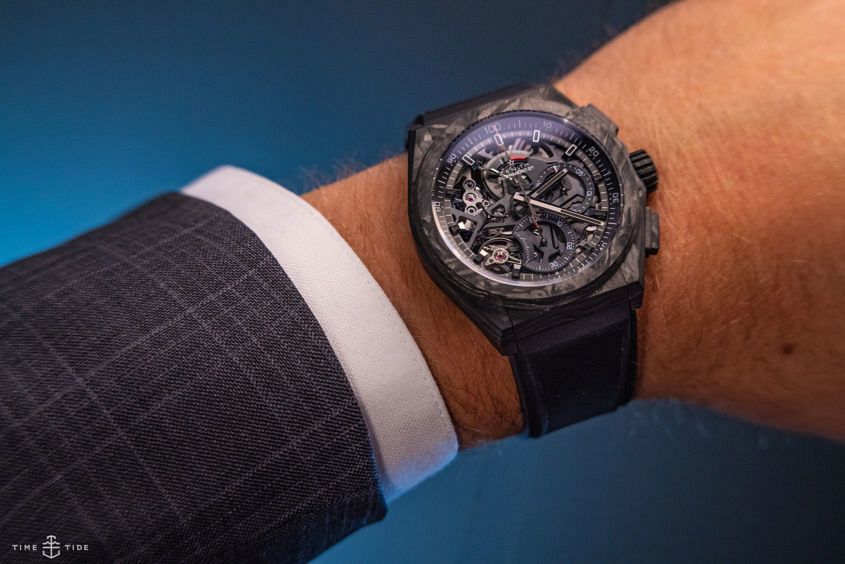 In the early years of the 21st century, Zenith was a brand that looked to the past — honouring their iconic El Primero in its original guise, and taking flights of nostalgic fancy with its Pilot’s collection. All fine watches, but comfortable takes on familiar forms. In 2017, the brand abruptly changed direction, with a thoroughly modern iteration of an old name — Defy — taking centre stage. One of the pillars of this new Zenith vision was the El Primero 21 (a watch we looked at in some detail here), which took the iconic high-frequency chronograph that is the El Primero and rocketed it to the next level. You see, the regular EP runs 5Hz, allowing 1/10th of a second accuracy. The chronograph on the El Primero 21 runs at a boggling 50Hz, meaning that the chrono hand makes a single revolution in a second, and offers 1/100th of a second accuracy. Of course this rate only applies to the chronograph operation; timekeeping runs at a more sedate and less power-hungry 5Hz, which is plenty accurate for day-to-day timekeeping. This year we were treated to a new take on the Defy: the 44mm case is offered here in carbon,…
In the early years of the 21st century, Zenith was a brand that looked to the past — honouring their iconic El Primero in its original guise, and taking flights of nostalgic fancy with its Pilot’s collection. All fine watches, but comfortable takes on familiar forms. In 2017, the brand abruptly changed direction, with a thoroughly modern iteration of an old name — Defy — taking centre stage. One of the pillars of this new Zenith vision was the El Primero 21 (a watch we looked at in some detail here), which took the iconic high-frequency chronograph that is the El Primero and rocketed it to the next level. You see, the regular EP runs 5Hz, allowing 1/10th of a second accuracy. The chronograph on the El Primero 21 runs at a boggling 50Hz, meaning that the chrono hand makes a single revolution in a second, and offers 1/100th of a second accuracy. Of course this rate only applies to the chronograph operation; timekeeping runs at a more sedate and less power-hungry 5Hz, which is plenty accurate for day-to-day timekeeping. This year we were treated to a new take on the Defy: the 44mm case is offered here in carbon,…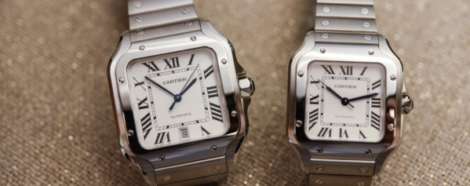

 There’s an inherent romance in all mechanical wristwatches — a romance drawn largely from the fact that these painstakingly created devices are fundamentally anachronistic machines that have been superseded several times over. Yet, still they manage to survive and, indeed, thrive. And it might just be me, but this romance factor is more present than ever when it comes to watches with celestial complications because — and let’s be real here — no one *needs* a moonphase in 2019. This fact is why the people who design and create this very traditional complication tend to show a bit of creative license. Such license was the name of the game in the montres department of the grand maison Hermès when they created the Hermès Arceau L’heure de la lune, which offers not one, but two moon phases (southern and northern hemispheres, don’t you know). You see, rather than moving the moons around the dial, Hermès have made the dials do the work. The time and date subdials sit above the base dial (of either meteorite or aventurine, two appropriately celestial materials) and, over the course of a month (or 28.5 days if you’re a pedant) revolve around the dial, obscuring or…
There’s an inherent romance in all mechanical wristwatches — a romance drawn largely from the fact that these painstakingly created devices are fundamentally anachronistic machines that have been superseded several times over. Yet, still they manage to survive and, indeed, thrive. And it might just be me, but this romance factor is more present than ever when it comes to watches with celestial complications because — and let’s be real here — no one *needs* a moonphase in 2019. This fact is why the people who design and create this very traditional complication tend to show a bit of creative license. Such license was the name of the game in the montres department of the grand maison Hermès when they created the Hermès Arceau L’heure de la lune, which offers not one, but two moon phases (southern and northern hemispheres, don’t you know). You see, rather than moving the moons around the dial, Hermès have made the dials do the work. The time and date subdials sit above the base dial (of either meteorite or aventurine, two appropriately celestial materials) and, over the course of a month (or 28.5 days if you’re a pedant) revolve around the dial, obscuring or…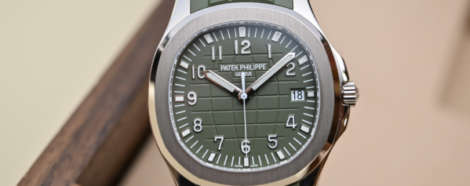
 It’s easy to forget or overlook the magnitude of what Hublot has achieved with their materials innovation — the scale and scope of their sapphire pieces is impressive to say the least, and their use of ceramic is amongst the most interesting in the business (which is no small feat given that every brand and its dog is making the most of the material at the moment). What really stands out with Hublot’s ceramic watches is their vivid tones. Last year’s Red Magic was one of the real bright spots (literally), with a hue that no other brand has managed to match. And this year’s Blue Magic doubles down on the trick — the 45mm sports chronograph is an outragesouly, awesomely bright blue. Polished blue ceramic aside, it is business as usual — the open dial, the one-click strap (blue, obvs) and the HUB1242 chronograph movement. This watch is limited to 500 pieces. It’s also a watch that leaves me wondering: what ceramic wonder will Hublot do next? Hublot Big Bang Unico Blue Magic price and availability Hublot Big Bang Unico Blue Magic, limited to 500 pieces, $27,000
It’s easy to forget or overlook the magnitude of what Hublot has achieved with their materials innovation — the scale and scope of their sapphire pieces is impressive to say the least, and their use of ceramic is amongst the most interesting in the business (which is no small feat given that every brand and its dog is making the most of the material at the moment). What really stands out with Hublot’s ceramic watches is their vivid tones. Last year’s Red Magic was one of the real bright spots (literally), with a hue that no other brand has managed to match. And this year’s Blue Magic doubles down on the trick — the 45mm sports chronograph is an outragesouly, awesomely bright blue. Polished blue ceramic aside, it is business as usual — the open dial, the one-click strap (blue, obvs) and the HUB1242 chronograph movement. This watch is limited to 500 pieces. It’s also a watch that leaves me wondering: what ceramic wonder will Hublot do next? Hublot Big Bang Unico Blue Magic price and availability Hublot Big Bang Unico Blue Magic, limited to 500 pieces, $27,000 This is one of those watches that makes so much sense I’m amazed it didn’t exist until now. But before we dive into the details of the IWC Big Pilot Edition ‘Right-Hander’, let’s step back and have a quick recap on the Big Pilot. The Big Pilot is a watch with two distinct histories. The first iteration of this story was the original watch, made as a navigational tool for wartime use. In this context, size = clarity and reliability. The civilian story of the Big Pilot begins in 2002, with the reference 5002. IWC’s revival of their historic design was perfectly pitched for the times, as big watches were all the rage, but few had the presence of IWC’s 46mm aviator. Seventeen years on and the Big Pilot is a staple of IWC’s lineup, offered in many material, complication and dial configurations over the years. But never — until now — a right-handed version. Quick primer on right and left-handed watches. Watches are intended to be worn on the less dominant hand, which, for most people, is the left. Ergonomics and good design dictates that a watch worn on the left hand should have its crown on the right…
This is one of those watches that makes so much sense I’m amazed it didn’t exist until now. But before we dive into the details of the IWC Big Pilot Edition ‘Right-Hander’, let’s step back and have a quick recap on the Big Pilot. The Big Pilot is a watch with two distinct histories. The first iteration of this story was the original watch, made as a navigational tool for wartime use. In this context, size = clarity and reliability. The civilian story of the Big Pilot begins in 2002, with the reference 5002. IWC’s revival of their historic design was perfectly pitched for the times, as big watches were all the rage, but few had the presence of IWC’s 46mm aviator. Seventeen years on and the Big Pilot is a staple of IWC’s lineup, offered in many material, complication and dial configurations over the years. But never — until now — a right-handed version. Quick primer on right and left-handed watches. Watches are intended to be worn on the less dominant hand, which, for most people, is the left. Ergonomics and good design dictates that a watch worn on the left hand should have its crown on the right…